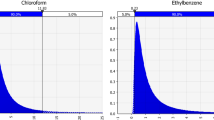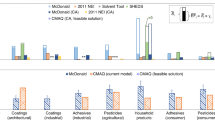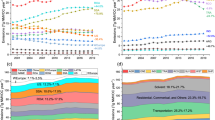Abstract
To begin to develop generalized models for estimating personal exposure to ambient air pollutants within diverse populations, the design of the Oklahoma Urban Air Toxics Study incorporated eight dichotomous macroenvironmental and household factors that were hypothesized to be potential determinants of exposure. Personal, indoor, and outdoor samples of volatile organic compounds (VOCs) were collected over 24-h monitoring periods in 42 households, together with activity diaries and data on the participants' residences. The distributions of the VOC concentrations were moderately to highly left-censored, and were mostly bimodal. The ATSDR minimal risk level (MRL) was exceeded in a small number of the samples. Personal and indoor concentrations tended to be higher than outdoor concentrations, indicating that indoor exposures were dominated by indoor sources. However, indoor concentrations were not correlated with the permeability of the residence, suggesting that the observed indoor concentrations reflected mostly localized, short-term emissions. The influence of the eight dichotomous factors and of the presence of an attached garage was evaluated using the Wilcoxon rank-sum test and by comparison of “excursion fractions”, that is, the fractions of each distributions exceeding 10% of the MRL. Dry weather and absence of children in the household were found to be associated with higher exposures in personal or indoor exposures. Given the small sample size, it is possible that these factors were confounded with unidentified household characteristics or activities that were the true determinants of exposure.
This is a preview of subscription content, access via your institution
Access options
Subscribe to this journal
Receive 6 print issues and online access
$259.00 per year
only $43.17 per issue
Buy this article
- Purchase on Springer Link
- Instant access to full article PDF
Prices may be subject to local taxes which are calculated during checkout











Similar content being viewed by others
References
ATSDR. Minimal risk levels for hazardous substances. Agency for Toxic Substances and Disease Registry, Atlanta GA, 2001, (available at http://www.atsdr.cdc.gov/mrls.html. accessed November 1, 2002).
Box G.E.P., Hunter W.G., and Hunter J.S. Statistics for Experimenters. John Wiley Interscience, New York, 1978.
Brownlee K.A. Statistical Theory and Methodology in Science and Engineering. John Wiley, New York, 1965.
Callahan M.A., Clickner R.P., Whitmore R.W., Kalton G., and Sexton K. Overview of important design issues for a National Human Exposure Assessment Survey. J Expos Anal Environ Epidemiol 1995: 5: 257–282.
Clayton C.A., Pellizzari E.D., Whitmore R.W., Perritt R.L., and Quackenboss J.J. National Human Exposure Assessment Survey (NHEXAS): distributions and associations of lead, arsenic and volatile organic compounds in EPA Region 5. J Expos Anal Environ Epidemiol 1999: 9: 381–392.
Gordon S.M., Callahan P.J., Nishioka M.G., Brinkman M.C., O’Rourke M.K., Lebowitz M.D., and Moschandreas D.J. Residential environmental measurements in the National Human Exposure Assessment Survey (NHEXAS) pilot study in Arizona: preliminary results for pesticides and VOCs. J Expos Anal Environ Epidemiol 1999: 9: 456–470.
Meier A. Infiltration: just ACH50 divided by 20? Home Energy 1994, January/February: 35–37.
Pellizzari E.D., Smith D.J., Clayton C.A., Michael L.C., and Quackenboss J.J. An assessment of the data quality for NHEXAS-Part I: exposure to metals and volatile organic chemicals in Region 5. J Expos Anal Environ Epidemiol 2001: 11: 140–154.
Phillips M.L., Hall T.A., Esmen N.A., Lynch R., and Johnson D.L. Use of global positioning system technology to track subjects’ location during environmental exposure sampling. J Expos Anal Environ Epidemiol 2001: 11: 207–215.
Sherman M. The use of blower-door data. LBL Report #35173. Lawrence Berkeley Laboratory, Berkeley, CA, 1998.
Wallace L.A. Comparison of risks from outdoor and indoor exposure to toxic chemicals. Environ Health Perspect 1991: 95: 7–13.
Wallace L., Nelson W., Ziegenfus R., Pellizzari E., Michael L., Whitmore R., Zelon H., Hartwell T., Perritt R., and Westerdahl D. The Los Angeles TEAM study: personal exposures, indoor–outdoor air concentrations, and breath concentrations of 25 volatile organic compounds. J Expos Anal Environ Epidemiol 1991: 1: 157–192.
Wallace L.A., Pellizzari E.D., Hartwell T.D., Sparacino C., Whitmore R., Sheldon L., Zelon H., and Perritt R. The TEAM study: personal exposures to toxic substances in air, drinking water, and breath of 400 residents of New Jersey, North Carolina, and North Dakota. Environ Res 1987: 43: 290–307.
Whitmore R.W., Byron M.Z., Clayton C.A., Thomas K.W., Zelon H.S., Pellizzari E.D., Lioy P.J., and Quackenboss J.J. Sampling design, response rates, and analysis weights for the National Human Exposure Assessment Survey (NHEXAS) in EPA Region 5. J Expos Anal Environ Epidemiol 1999: 9: 369–380.
Acknowledgements
This research was supported by the US Environmental Protection Agency under Agreement No. R82-6786-010, the Presbyterian Health Foundation/Provost's Research Fund, and the University of Oklahoma College of Public Health. We thank research assistants S. Foerster, A. Gibson, S.K. Moss, A. Patel, A. Shamhart, and D. Wang, as well as all of the study participants.
Author information
Authors and Affiliations
Corresponding author
Rights and permissions
About this article
Cite this article
Phillips, M., Esmen, N., Hall, T. et al. Determinants of exposure to volatile organic compounds in four Oklahoma cities. J Expo Sci Environ Epidemiol 15, 35–46 (2005). https://doi.org/10.1038/sj.jea.7500347
Received:
Accepted:
Published:
Issue Date:
DOI: https://doi.org/10.1038/sj.jea.7500347
Keywords
This article is cited by
-
Exposure Modeling of Benzene Exploiting Passive–Active Sampling Data
Environmental Modeling & Assessment (2010)
-
Exposure information in environmental health research: Current opportunities and future directions for particulate matter, ozone, and toxic air pollutants
Journal of Exposure Science & Environmental Epidemiology (2009)
-
Indoor/ambient residential air toxics results in rural western Montana
Environmental Monitoring and Assessment (2009)



